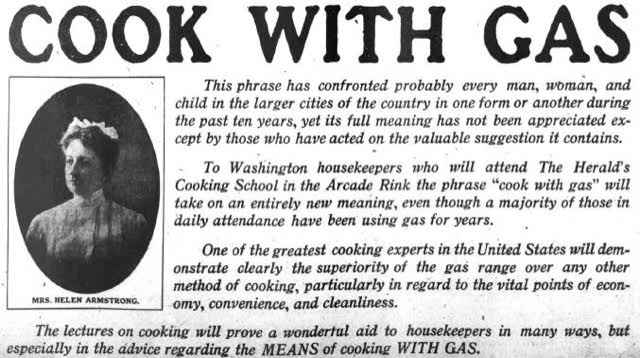
I saw a blog on Treehugger that environmental engineering professor Shelly L Miller tweeted a whole rush of scientific papers on the health effects of air emissions from gas stoves, so I had to run right over to her Twitter page and get them for you. Imagine my surprise when I arrived on her page and Twitter said Shelly “follows you.”
As a home cook I am a fan of using gas over electric, and thought I was doing OK because I kept my stove well-adjusted. But when I started checking my indoor air with a real-time monitor, the VOCs spiked every time I cooked something on the stove.
Now here’s the scientific data about how that’s harmful to health.
BTW, I’m no longer cooking with gas. I either use my induction burner in my tiny kitchen or my mother-in-law’s electric stove.
NOTE some of these links are unclear, but I’ve just put everything here as I found it. I’ll continue to add to this list and feel free to add studies you find in the comments.
From Shelly Miller’s:
Induction stoves a great option for consumers to move towards a fossil-fuel free home, plus it eliminates a huge source of pollution (NO2, CO, particles) in the home. #healthyhome #indoorairpollution
7 Aug 2018
Get ready, I’ll be posting a bunch of references/studies on the association between adverse respiratory health and gas stoves #sciencetwitter #indoorairpollution #healthyhomes
8:46 AM – 8 Aug 2018
From the #SixCities study: strong evidence for causal effect of 2ndhand smoke on increased respiratory illness and exposure to gas stoves associated with reduced pulmonary function – all in children. https://www.atsjournals.org/doi/pdf/10.1164/arrd.1984.129.3.366 …
8:51 AM – 8 Aug 2018
Respiratory symptoms were more common in children exposed to a gas stove. “Respiratory Symptoms in Children and Indoor Exposure to Nitrogen Dioxide and Gas Stoves” | American Journal of Respiratory and Critical Care Medicine https://www.atsjournals.org/doi/abs/10.1164/ajrccm.158.3.9701084 …
8:53 AM – 8 Aug 2018
Women who used gas for cooking had increased risk of asthma-like symptoms and had reduced lung function and increased airways obstruction compared to those who did not use gas https://www.sciencedirect.com/science/article/pii/S0140673696900094 …
8:56 M – 8 Aug 2018
Children from households with gas stoves had a greater history of respiratory illness before age 2 and small but significantly lower levels of FEV1 and FVC corrected for height https://www.atsjournals.org/doi/abs/10.1164/arrd.1980.121.1.3 …
9:02 AM – 8 Aug 2018
#openaccess and shows the impact of using ventilation while cooking Shelly L Miller added,
9:05 AM – 8 Aug 2018
In homes using gas stoves, children whose parents reported using ventilation when using the stove had higher lung function and lower odds of asthma, wheeze, bronchitis compared to homes that never used ventilation or did not have ventilation available
9:05 AM – 8 Aug 2018
OK thats enough on gas stoves & respiratory health for now. Over 25 years ago when I was a PhD student at Berkeley talking to an EPA scientist about the most important #indoorairquality issue, and he said: gas stoves, because the association with adverse health is clear.
9:16 AM – 8 Aug 2018
And yet another study showing CO2 levels in offices above 1000 ppm causes lower cognitive functioning. Great study @j_g_allen Shelly L Miller added,
9:17 PM – 9 Aug 2018




Debra,
We have a gas oven with gas cooktop above it. We do use the exhaust fan when we use either part. But I read that the oven can leave chemicals in the food. Have you heard this? I didn’t read the articles because they all appear to be just about respiratory function associated with the cooktop. Thanks!
If the oven is outgassing any chemicals they can get into the food, yes.
Not all stove fans vent to the outside. Some fans just circulate the air through a filter. I wonder if a specific filter is useful for gas combustion by-products.
I looked this up because the only type of filter I’ve ever seen for a range hood is metal mesh that you can wash to remove the grease. And then you re-install the same filter.
I found a reference to “ductless range hoods”, which is what I think you are referring to.
It says
So it appears that your ductless range hood already had a charcoal fiter that would remove combustion by-products.
I thought there were concerns about EMF’s from Induction stoves? I’m about to select a new cooktop, the induction is tempting as it would be easier (safer) for my kids to cook on, however my research caused me to look at gas again, as so many people use it. We did just install and great exhaust fan above.
I have used gas stoves for many years but you MUST use an exhaust fan.
I currently use an induction cooktop because I can’t install gas where I am cooking at the moment.
Debra, for those of us who have gas stoves (and want to use it as safely as possible around children), does “ventilation” refer to using the fan above the stove? I do use the fan, though I don’t open windows in the house while cooking. If that’s the best one can do for now, it seems like at least using the fan is beneficial, as one of the tweets states “In homes using gas stoves, children whose parents reported using ventilation when using the stove had higher lung function and lower odds of asthma, wheeze, bronchitis compared to homes that never used ventilation or did not have ventilation available” — and I am thinking in terms of both the adults and the children, though this tween only mentions the children.
Yes. Those fans above the stove are exhaust fans and are there precisely to remove residues from cooking to the outside so they don’t spread throughout the home.